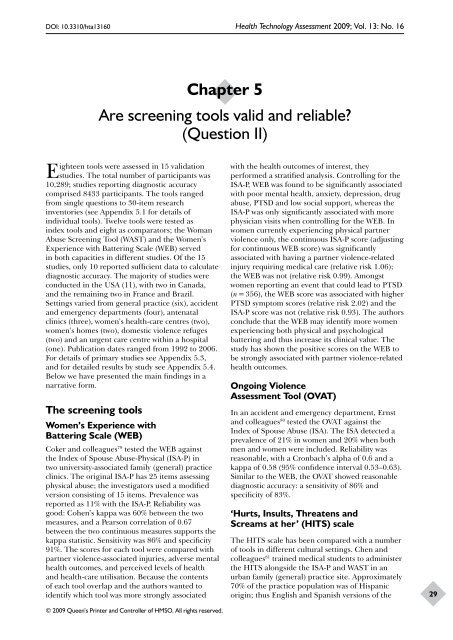How far does screening women for domestic (partner) - NIHR Health ...
How far does screening women for domestic (partner) - NIHR Health ...
How far does screening women for domestic (partner) - NIHR Health ...
You also want an ePaper? Increase the reach of your titles
YUMPU automatically turns print PDFs into web optimized ePapers that Google loves.
DOI: 10.3310/hta13160 <strong>Health</strong> Technology Assessment 2009; Vol. 13: No. 16<br />
© 2009 Queen’s Printer and Controller of HMSO. All rights reserved.<br />
Chapter 5<br />
Are <strong>screening</strong> tools valid and reliable?<br />
(Question II)<br />
Eighteen tools were assessed in 15 validation<br />
studies. The total number of participants was<br />
10,289; studies reporting diagnostic accuracy<br />
comprised 8433 participants. The tools ranged<br />
from single questions to 30-item research<br />
inventories (see Appendix 5.1 <strong>for</strong> details of<br />
individual tools). Twelve tools were tested as<br />
index tools and eight as comparators; the Woman<br />
Abuse Screening Tool (WAST) and the Women’s<br />
Experience with Battering Scale (WEB) served<br />
in both capacities in different studies. Of the 15<br />
studies, only 10 reported sufficient data to calculate<br />
diagnostic accuracy. The majority of studies were<br />
conducted in the USA (11), with two in Canada,<br />
and the remaining two in France and Brazil.<br />
Settings varied from general practice (six), accident<br />
and emergency departments (four), antenatal<br />
clinics (three), <strong>women</strong>’s health-care centres (two),<br />
<strong>women</strong>’s homes (two), <strong>domestic</strong> violence refuges<br />
(two) and an urgent care centre within a hospital<br />
(one). Publication dates ranged from 1992 to 2006.<br />
For details of primary studies see Appendix 5.3,<br />
and <strong>for</strong> detailed results by study see Appendix 5.4.<br />
Below we have presented the main findings in a<br />
narrative <strong>for</strong>m.<br />
The <strong>screening</strong> tools<br />
Women’s Experience with<br />
Battering Scale (WEB)<br />
Coker and colleagues 79 tested the WEB against<br />
the Index of Spouse Abuse-Physical (ISA-P) in<br />
two university-associated family (general) practice<br />
clinics. The original ISA-P has 25 items assessing<br />
physical abuse; the investigators used a modified<br />
version consisting of 15 items. Prevalence was<br />
reported as 11% with the ISA-P. Reliability was<br />
good: Cohen’s kappa was 60% between the two<br />
measures, and a Pearson correlation of 0.67<br />
between the two continuous measures supports the<br />
kappa statistic. Sensitivity was 86% and specificity<br />
91%. The scores <strong>for</strong> each tool were compared with<br />
<strong>partner</strong> violence-associated injuries, adverse mental<br />
health outcomes, and perceived levels of health<br />
and health-care utilisation. Because the contents<br />
of each tool overlap and the authors wanted to<br />
identify which tool was more strongly associated<br />
with the health outcomes of interest, they<br />
per<strong>for</strong>med a stratified analysis. Controlling <strong>for</strong> the<br />
ISA-P, WEB was found to be significantly associated<br />
with poor mental health, anxiety, depression, drug<br />
abuse, PTSD and low social support, whereas the<br />
ISA-P was only significantly associated with more<br />
physician visits when controlling <strong>for</strong> the WEB. In<br />
<strong>women</strong> currently experiencing physical <strong>partner</strong><br />
violence only, the continuous ISA-P score (adjusting<br />
<strong>for</strong> continuous WEB score) was significantly<br />
associated with having a <strong>partner</strong> violence-related<br />
injury requiring medical care (relative risk 1.06);<br />
the WEB was not (relative risk 0.99). Amongst<br />
<strong>women</strong> reporting an event that could lead to PTSD<br />
(n = 356), the WEB score was associated with higher<br />
PTSD symptom scores (relative risk 2.02) and the<br />
ISA-P score was not (relative risk 0.93). The authors<br />
conclude that the WEB may identify more <strong>women</strong><br />
experiencing both physical and psychological<br />
battering and thus increase its clinical value. The<br />
study has shown the positive scores on the WEB to<br />
be strongly associated with <strong>partner</strong> violence-related<br />
health outcomes.<br />
Ongoing Violence<br />
Assessment Tool (OVAT)<br />
In an accident and emergency department, Ernst<br />
and colleagues 80 tested the OVAT against the<br />
Index of Spouse Abuse (ISA). The ISA detected a<br />
prevalence of 21% in <strong>women</strong> and 20% when both<br />
men and <strong>women</strong> were included. Reliability was<br />
reasonable, with a Cronbach’s alpha of 0.6 and a<br />
kappa of 0.58 (95% confidence interval 0.53–0.63).<br />
Similar to the WEB, the OVAT showed reasonable<br />
diagnostic accuracy: a sensitivity of 86% and<br />
specificity of 83%.<br />
‘Hurts, Insults, Threatens and<br />
Screams at her’ (HITS) scale<br />
The HITS scale has been compared with a number<br />
of tools in different cultural settings. Chen and<br />
colleagues 81 trained medical students to administer<br />
the HITS alongside the ISA-P and WAST in an<br />
urban family (general) practice site. Approximately<br />
70% of the practice population was of Hispanic<br />
origin; thus English and Spanish versions of the<br />
29
















